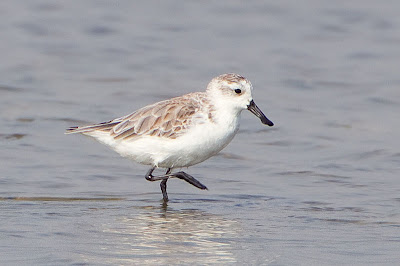 |
| When the Mikado behaves. |
Spring is the most popular time for seeing the endemics. However, there is nothing particularly wrong with other seasons - and early winter should be considered too. A couple of the key birds are very quiet, but the reduced foliage (better views), and winter visitors makes up for this.
In November I made three 3-day trips to the Dasyueshan area with clients photographing the endemics. Despite encountering unseasonable rain several times, a good array of birds were seen and photographed. Below is a list of birds seen with an indication of how many of the 3 trips each species was seen on. About half of these species were photographed to varying degrees of success. The Formosan Blue Magpie, and Black-faced Spoonbill were found at other locations. I hope this is useful for anyone planning a trip there.
Highlights for me were: the pheasants (Swinhoe’s, Mikado) showing well, the elusive Island Thrush on two trips (km mark 23.5), Siberian Rubythroat (near km 4, would love to twitch the Bluethroat in Huajiang), the larger mammals. Still have not encountered the Plain Flowerpecker (the only endemic subspecies not seen this year!) may put some effort into getting it in this last month!
Taiwan Hill Partridge (heard only, 2), Bamboo Partridge (heard only, 3), Swinhoe’s Pheasant (3), Mikado Pheasant (3), Little Egret (2), Black-crowned Night-Heron (2), Striated Heron (2), Malayan Night-Heron (1), Black Eagle (1), Japanese Sparrowhawk (1), Besra (1?), Crested Serpent Eagle (1), Doves - Spotted/Red Collared/Rock, Ashy Wood Pigeon (2), Fork-tailed Swift (2), Common Kingfisher (3), Taiwan Barbet (3), Grey-chinned Minivet (2), Brown Shrike (2), Long-tailed Shrike (2), Black Drongo (3), Ashy Drongo (1), Bronzed Drongo (2), Black-naped Monarch (3), Eurasian Jay (2), Gray Treepie (3), Eurasian Nutcracker (3), Large-billed Crow (2), Oriental Skylark (1), Barn Swallow (2), Coal Tit (3), Green-backed Tit (3), Yellow Tit (0!), Brownish-flanked Bush-Warbler (2), Yellow-bellied Bush-Warbler (2), Rufous-faced Bush-Warbler (3), Black-throated Tit, Eurasian Nuthatch (3), Eurasian Wren (1), Brown Dipper (1), Collared Finchbill (3), Light-vented Bulbul (3), Black Bulbul (3), Flamecrest (1), Arctic Warbler (2), Other Phylloscopus Warbler (1), Zitting Cisticola (1), Striated Prinia (1), Yellow-bellied Prinia (2), Plain Prinia (3), Vinous-throated Parrotbill (1), Vivid Niltava (2), Siberian Rubythroat (2), White-browed Bush-Robin (1), Collared Bush-Robin (3), Daurian Redstart (3), Plumbeous Redstart (3), White-tailed Robin (2), Little Forktail (1), Stonechat (1), Pale Thrush (1), White-browed Shortwing (1, also heard), Rufous-crowned Laughingthrush (1), Rusty Laughingthrush (1), Taiwan Hwamei (3), White-whiskered Laughingthrush (3), Taiwan Liocichla (2 or 3), Black-necklaced Scimitar-Babbler (1), Taiwan Scimitar-Babbler (3), Taiwan Wren-Babbler (Cupwing) (1), Rufous-capped Babbler (3), Taiwan Barwing (2), Taiwan Fulvetta (3), Dusky Fulvetta (2 or 3), Gray-cheeked Fulvetta (3), White-eared (Taiwan) Sibia (3), Taiwan Yuhina (3), White-bellied Erponis (1), Japanese White-eye (3), Myna sp, Fire-breasted Flowerpecker (3), Gray Wagtail (3), Richard’s Pipit (1), Vinaceous (Taiwan) Rosefinch (2), Eurasian Siskin (2), Eurasian Tree Sparrow (3), Indian Silverbill (1), White-rumped Munia (3), Scaly-breasted Munia (2), Gray-capped Woodpecker (3), White-backed Woodpecker (1), House Swift (1?), Scaly Thrush (2), Eye-browed Thrush (3), Formosan Whistling-Thrush (2, also heard), Spot-billed Duck (1), White-bellied Pigeon (1), White-rumped Shama (1), Asian House-Martin (1),
Mammals: Macaque (3), Serow (2), Muntjac, (2), Golden Weasel (1), Ferret-Badger (1), White-faced Flying Squirrel (2), Formosan Giant Flying Squirrel (1), Striped Squirrel (3), Owston's Long-nosed Tree Squirrel (2). Oh yes - a strange sort of ‘steel wire’ worm...will update here.
New Birds in Dasyueshan:
Eurasian Siskin Spinus spinus
Other places other birds:
New Birds in Sicao, Tainan (when chasing more exotic Japanese Robin, Verditer Flycatcher, Red-breasted Flycatcher, Blue-and-white Flycatcher...and failing) in or near the small coastal forest on the north and south of the Tsengwen River estuary. A much lower point was the fact I tried to twitch a Daurian Crow in Puli. Bad!
Eastern Marsh-Harrier Circus spilonotus
Yellow-fronted Canary Serinus mozambicus
Black-browed Reed-Warbler Acrocephalus bistrigiceps
Taichung Metropolitan Park.
Not a big fan of heavily-manicured dog-ridden city parks, but found some wilder bits on the western edges (facing onto Freeway # 3 sort of). Will visit this area on Dadu 'Mountain' again. Just south of Taichung airport - has flights from Hong Kong, very handy if wanting to get into the best areas quickly. Lots of thrushes (Eyebrowed, Dusky, Pale, Brown-headed - and a possible Japanese) around.
Naumann's Thrush Turdus naumanni







